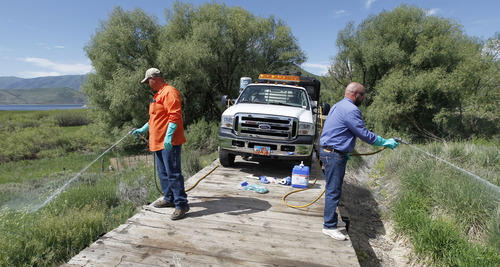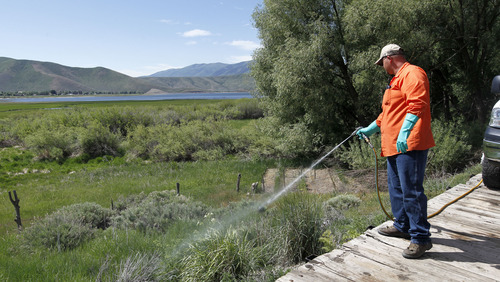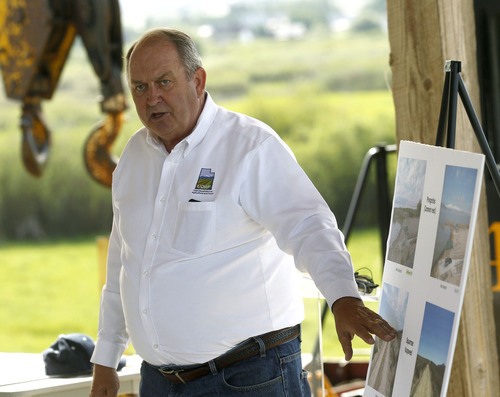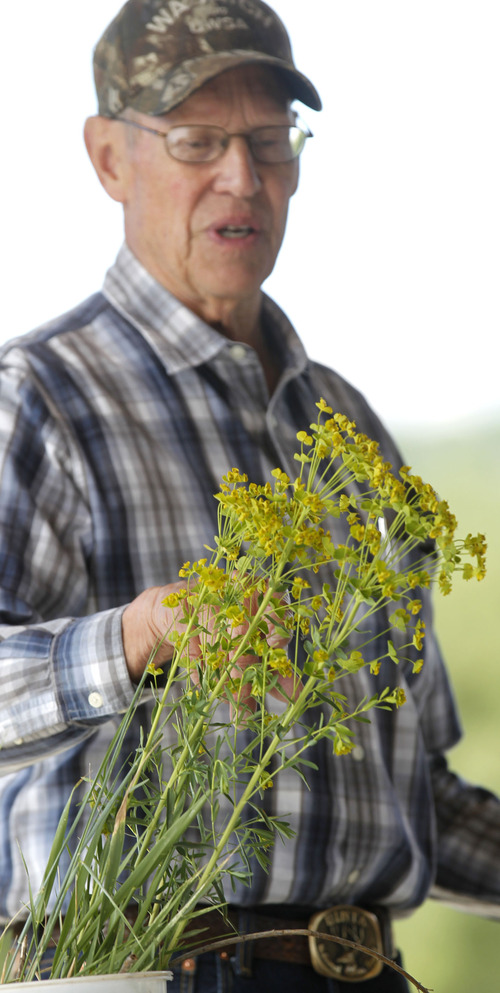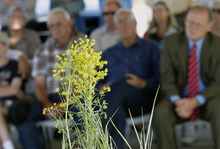This is an archived article that was published on sltrib.com in 2013, and information in the article may be outdated. It is provided only for personal research purposes and may not be reprinted.
Soldier Hollow •Utah's "War on Weeds" got more ammunition Monday when various agencies and community groups unveiled a $1.3 million state grant and weed-tracking phone app.
"Our innovation must continue if we're going to keep up with the local and world demand for food," Utah Commissioner of Agriculture and Food Leonard Blackham said at a news conference. "And controlling weeds and invasive (plants) is a big part of that."
Blackham said if left unchecked, "often times an entire area can become basically unproductive for livestock, for food production or for wildlife or even for meaningful recreation."
Blackham spoke in front of a bucket holding Wasatch County's worst enemy: leafy spurge.
The 3-foot-tall plant has narrow leaves on its stalks and blossoms with bright, beautiful flowers around this time of year. But the Eurasia-native contains a white substance poisonous to livestock.
"Besides being pretty, it has a root system that probably goes about 15 feet down in the ground, sometimes even farther than that," said Steve Smith, chairman of the Wasatch Cooperative Weed Management Area.
When leafy spurge matures, it explodes seeds that are sent up to 15 feet in all directions.
Invasive plants aren't unique to Wasatch County. Salt Lake has as many as 250 species that are non-native. Some weeds have spread to all 29 counties and out of state.
In the southwestern Utah, Mike Melton manages wildfire efforts for the Division of Forestry, Fire and State Lands. Melton's worst enemy in the war is known as cheatgrass — what he calls "biological gasoline."
"The thing that it does is it greens up early in the spring and it out-competes the natural grasses" early in the growing season, Melton said.
The invasive grass then dries out in summer, and acts like a highly flammable fuel that contributes to the record wildfires the state saw last year.
The state agencies said a free smart phone application called EDDMapS West can help Utah unite with residents in other states to prevent new weeds coming in or heading out across state borders.
Jerry Caldwell, president of the Utah Weed Supervisors Association, gave details about the app as Rep. Kraig Powell, R-Heber City, pulled out his phone to download it. Users identify invasive species with their phones and report their location, which state employees then verify.
Caldwell said the state can and already has used the app to identify plants that are spreading north from Arizona and south from Idaho into Utah. Those states can also survey weeds coming from the Beehive State.
Smith said counties can use natural weapons, like beetles, goats and sheep, which eat the plants. But attendees and organizers used a Heber Valley Railroad train loaded with a truck and 250-gallon chemical tank to spray herbicide on leafy spurge and poison hemlock along the railway north of Deer Creek reservoir.
@taylorwanderson


